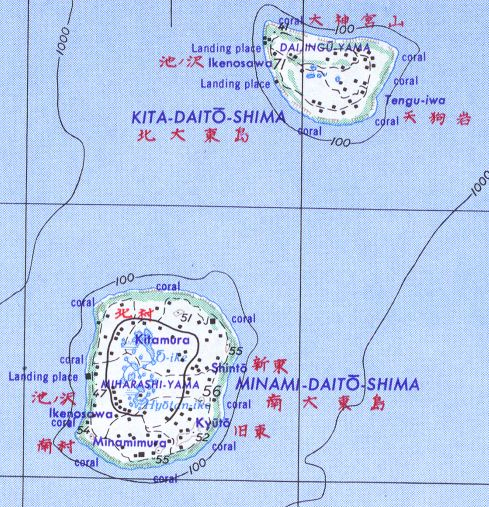|
Kitadaitōjima
, also spelled as Kita Daitō, Kita-Daitō-shima, and Kitadaitō, is the northernmost island in the Daitō Islands group, located in the Philippine Sea southeast of Okinawa, Japan. It is administered as part of the village of Kitadaitō, Shimajiri District, Okinawa. The island is entirely cultivated for agriculture. The island has no beaches but has a fishing harbor, three ferry docks and an airport (Kitadaito Airport) (airport code "KTD") for local flights. Geography Kitadaitōjima is a relatively isolated coralline island, located approximately north of Minamidaitōjima, the largest island of the archipelago, and from Naha, Okinawa. As with the other islands in the archipelago, Kitadaitōjima is an uplifted coral atoll with a steep coastal cliff of limestone (the former fringing coral reef of the island), and a depressed center (the former lagoon of the island). The island is roughly oval in shape, with a circumference of about , length of and an area of . The highest poi ... [...More Info...] [...Related Items...] OR: [Wikipedia] [Google] [Baidu] |
Daitō Islands
The are an archipelago consisting of three isolated coral islands, administered by Japan, in the Philippine Sea southeast of Okinawa Prefecture, Okinawa. The islands have a total area of and a population of 2,107. Administratively, the whole group belongs to Shimajiri District, Okinawa, Shimajiri District of Okinawa Prefecture, and is divided between the villages of Minamidaitō, Okinawa, Minamidaitō and Kitadaitō, Okinawa, Kitadaitō, with uninhabited Okidaitōjima island administered as part of Kitadaitō municipality, although physically located closer to Minamidaitōjima. Etymology ''Kita'', ''minami'', and ''oki'' means, respectively, "north", "south", and "offshore" while ''daitō'' means "great east". History These islands have long been known in Okinawa as ''Ufuagari'' (“the Great East”). Okidaitōjima was first sighted by the Spanish Empire, Spanish Spanish explorers, explorer Bernardo de la Torre on 25 September 1543 during a failed attempt to find a northern r ... [...More Info...] [...Related Items...] OR: [Wikipedia] [Google] [Baidu] |
Kitadaitō, Okinawa
is a List of villages in Japan, village consisting of the islands of Kitadaitōjima and Okidaitōjima of Shimajiri District, Okinawa, Shimajiri District, Okinawa Prefecture, Japan. As of October 2016, the village has an estimated population of 615 and a population density, density of 47 persons per km2. The total area is 13.10 km2. All of the inhabitants live on Kitadaitōjima. Geography Kitadaitō Island is located about 360 km east of Okinawa Island. It is the easternmost island in Okinawa Prefecture. The island shows characteristic landscape of a raised coral reef island, with a very flat area in its centre. Okidaitō Island is entirely the private property of the Rasae Group, that used to exploit phosphate ore there. It was then rented by the United States Forces Japan, U.S. Forces in Japan as a shooting range, that started to be used conjointly by the Japan Self Defence Forces in 2015. It is off limits to civilians and currently uninhabited. Area * Kitadaitō Islan ... [...More Info...] [...Related Items...] OR: [Wikipedia] [Google] [Baidu] |
Minamidaitōjima
, also spelt as Minami Daitō or Minami-Daitō, is the largest island in the Daitō Islands group southeast of Okinawa, Japan. It is administered as part of the village of Minamidaitō, Okinawa. Shimajiri District, Okinawa and has a population of 2,107. The island is entirely cultivated for agriculture. The island has no beaches but has a fishing boat harbor and three cargo and ferry ports; as well as an airport Minami Daito Airport (airport code "MMD"). Geography Minamidaitōjima is a relatively isolated coralline island, located approximately south of Kitadaitōjima, the second largest island of the archipelago, and from Naha, Okinawa. As with the other islands in the archipelago, Minamidaitōjima is an uplifted coral atoll with a steep coastal cliff of limestone (the former fringing coral reef of the island), and a depressed center (the former lagoon of the island). The island is roughly oval in shape, with a circumference of about , length of and an area of . The ... [...More Info...] [...Related Items...] OR: [Wikipedia] [Google] [Baidu] |
Okinawa Prefecture
is the southernmost and westernmost prefecture of Japan. It consists of three main island groups—the Okinawa Islands, the Sakishima Islands, and the Daitō Islands—spread across a maritime zone approximately 1,000 kilometers east to west and 400 kilometers north to south. Despite a modest land area of 2,281 km² (880 sq mi), Okinawa’s territorial extent over surrounding seas makes its total area nearly half the combined size of Honshu, Shikoku, and Kyushu. Of its 160 Island, islands, 49 are inhabited. The largest and most populous island is Okinawa Island, which hosts the capital city, Naha, as well as major urban centers such as Okinawa (city), Okinawa, Uruma, and Urasoe, Okinawa, Urasoe. The prefecture has a subtropical climate, characterized by warm temperatures and high rainfall throughout the year. People from the Ryukyu Islands, Nansei Islands, including Okinawa Island, Okinawa, the Sakishima Islands, and parts of Kagoshima Prefecture, are often collectively referred ... [...More Info...] [...Related Items...] OR: [Wikipedia] [Google] [Baidu] |
Kitadaito Airport
is located on the island of Kitadaitōjima in the village of Kitadaitō, Shimajiri District, Okinawa Prefecture, Japan. The prefecture operates the airport, which is classified as a third class airport. Only a flight from Naha to Kitadaitō is operated every day. History Kitadaito Airport was opened in 1971 as an emergency 760 meter airstrip, constructed of crushed coral by the United States Civil Administration of the Ryukyu Islands. The runway was paved and extended to 800 meters in 1978, when scheduled passenger services commenced. The runway was extended to 1500 meters in 1997. At present, there is only one scheduled flight per day. Airlines and destinations References External links Kitadaito Airport from ''Japan Airlines Japan Airlines (JAL) is the flag carrier airline of Japan. JAL is headquartered in Shinagawa, Tokyo. Its main hubs are Tokyo's Narita International Airport, Narita and Haneda Airport, Haneda airports, as well as secondary hubs in Osaka's K ... [...More Info...] [...Related Items...] OR: [Wikipedia] [Google] [Baidu] |
Philippine Sea
The Philippine Sea is a List of seas#Marginal seas by ocean, marginal sea of the Pacific Ocean, Western Pacific Ocean east of the list of islands of the Philippines, Philippine Archipelago (hence the name) and the List of seas#Largest seas by area, largest sea in the world, occupying an estimated surface area of . The Philippine Sea Plate forms the floor of the sea. Its western border is the first island chain to the west, comprising the Ryukyu Islands in the northwest and Taiwan in the west. Its southwestern border comprises the Philippines, Philippine islands of Luzon, Catanduanes, Samar, Leyte, and Mindanao. Its northern border comprises the Japanese islands of Honshu, Shikoku and Kyūshū. Its eastern border is the second island chain to the east, comprising the Bonin Islands and Iwo Jima in the northeast, the Mariana Islands (including Guam, Saipan, and Tinian) in the due east, and Halmahera, Palau, Yap and Ulithi (of the Caroline Islands) in the southeast. Its southern ... [...More Info...] [...Related Items...] OR: [Wikipedia] [Google] [Baidu] |
Bernardo De La Torre
Bernardo de la Torre or della Torres (died 1545) was a Spanish explorer during the Age of Discovery. He participated in Ruy López de Villalobos's failed expedition to establish a greater Spanish presence in the East Indies. Stuck for months on the eastern side of Mindanao, the expedition ran low on supplies, suffered repeated accidents, and was discovered and ordered to leave by the Portuguese. López de Villalobos sent De la Torre east across the Pacific Ocean to seek supplies and reinforcements from Mexico. Attempting a new northern route, De la Torre discovered the Volcano Islandswhich he named after an eruption active as he passedbefore being forced to turn back from lack of water and high storm waves. During this return voyage, his ship became the first known to have circumnavigated Mindanao. De la Torre is sometimes further claimed to have named Mindanao Caesarea Caroli in honor of the Habsburg emperor CharlesV; to have named Leyte and Samar the Philippines in honor of t ... [...More Info...] [...Related Items...] OR: [Wikipedia] [Google] [Baidu] |
Empire Of Japan
The Empire of Japan, also known as the Japanese Empire or Imperial Japan, was the Japanese nation state that existed from the Meiji Restoration on January 3, 1868, until the Constitution of Japan took effect on May 3, 1947. From Japan–Korea Treaty of 1910, 1910 to Japanese Instrument of Surrender, 1945, it included the Japanese archipelago, the Kuril Islands, Kurils, Karafuto Prefecture, Karafuto, Korea under Japanese rule, Korea, and Taiwan under Japanese rule, Taiwan. The South Seas Mandate and Foreign concessions in China#List of concessions, concessions such as the Kwantung Leased Territory were ''de jure'' not internal parts of the empire but dependent territories. In the closing stages of World War II, with Japan defeated alongside the rest of the Axis powers, the Japanese Instrument of Surrender, formalized surrender was issued on September 2, 1945, in compliance with the Potsdam Declaration of the Allies of World War II, Allies, and the empire's territory subsequent ... [...More Info...] [...Related Items...] OR: [Wikipedia] [Google] [Baidu] |
Sugar Cane
Sugarcane or sugar cane is a species of tall, Perennial plant, perennial grass (in the genus ''Saccharum'', tribe Andropogoneae) that is used for sugar Sugar industry, production. The plants are 2–6 m (6–20 ft) tall with stout, jointed, fibrous stalks that are rich in sucrose, which accumulates in the Plant stem, stalk internodes. Sugarcanes belong to the grass family, Poaceae, an economically important flowering plant family that includes maize, wheat, rice, and sorghum, and many forage crops. It is native to New Guinea. Sugarcane was an ancient crop of the Austronesian people, Austronesian and Indigenous people of New Guinea, Papuan people. The best evidence available today points to the New Guinea area as the site of the original domestication of ''Saccharum officinarum''. It was introduced to Polynesia, Island Melanesia, and Madagascar in prehistoric times via Austronesian sailors. It was also introduced by Austronesian sailors to India and then to Southern China by 500 ... [...More Info...] [...Related Items...] OR: [Wikipedia] [Google] [Baidu] |
Tamaoki Han'emon
Tamaoki (written: 玉置) is a Japanese surname Japanese may refer to: * Something from or related to Japan, an island country in East Asia * Japanese language, spoken mainly in Japan * Japanese people, the ethnic group that identifies with Japan through ancestry or culture ** Japanese diaspor .... Notable people with the surname include: *, Japanese manga artist *, Japanese judoka {{surname Japanese-language surnames ... [...More Info...] [...Related Items...] OR: [Wikipedia] [Google] [Baidu] |
Köppen Climate Classification
The Köppen climate classification divides Earth climates into five main climate groups, with each group being divided based on patterns of seasonal precipitation and temperature. The five main groups are ''A'' (tropical), ''B'' (arid), ''C'' (temperate), ''D'' (continental), and ''E'' (polar). Each group and subgroup is represented by a letter. All climates are assigned a main group (the first letter). All climates except for those in the ''E'' group are assigned a seasonal precipitation subgroup (the second letter). For example, ''Af'' indicates a tropical rainforest climate. The system assigns a temperature subgroup for all groups other than those in the ''A'' group, indicated by the third letter for climates in ''B'', ''C'', ''D'', and the second letter for climates in ''E''. Other examples include: ''Cfb'' indicating an oceanic climate with warm summers as indicated by the ending ''b.'', while ''Dwb'' indicates a semi-Monsoon continental climate, monsoonal continental climate ... [...More Info...] [...Related Items...] OR: [Wikipedia] [Google] [Baidu] |





